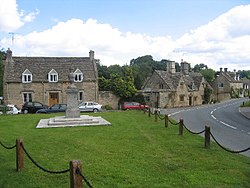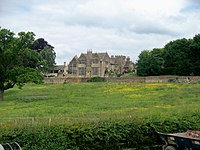Lower Swell
| Lower Swell | |
| Gloucestershire | |
|---|---|
 Lower Swell War Memorial on the village green | |
| Location | |
| Grid reference: | SP173254 |
| Location: | 51°55’38"N, 1°44’57"W |
| Data | |
| Population: | 405 |
| Post town: | Stow-on-the-Wold |
| Postcode: | GL54 |
| Dialling code: | 01451 |
| Local Government | |
| Council: | Cotswold |
| Parliamentary constituency: |
The Cotswolds |
Lower Swell is a village and a parish in Gloucestershire. It is located at the River Dikler, one mile from Stow-on-the-Wold.[1] The village has "finest countryside, a tranquil village green and plenty of mellow stone cottages".
The village church is dedicated to St Mary.[1]
Origin of the name
The origin of the name 'Swell' is unknown. Daniel Henry Haigh, a noted Victorian scholar of Anglo-Saxon history and literature, determined that "swell" means "burning", or "funeral pile",[2] from the Old English swelan, 'to burn'. He asserted that King Offa of the Mercians fought a battle in the vicinity of Lower Swell. David Royce, Vicar of Lower Swell, said that during the reconstruction of the church "a long deep bed of ashes was discovered in his churchyard, and that, of eleven barrows in the parish, the largest is called Picked Morden, a name which seems equivalent to "selected slain".[2] After he heard this testimony, Haigh came to the conclusion that the place where the Lower Swell church stands now was once used to bury "the burnt corpses of the nobles".[2]
However, another theory, the name "Swell" came about from the protuberant contours on the western side of the Dikler river.
The most widely accepted theory behind the name "Swell" is that it relates to a spring that rises in the grounds of the Abbotswood Estate to the north of the village and is an abbreviated version of "Our Lady's Well". The well can still be seen today.
History of the village
In the Middle Ages the village's name was Little Swell.
Documents indicate that the village was well developed by the 17th century, but was probably initially developed even earlier.[3] The oldest extant buildings are dated to the 17th century. A notable 18th-century building that was built in 1786 is named the "Golden Ball".
Another interesting building was constructed in 1807; a spa building built in Hindu style. It was promoted as a spa because of the mineral rich well that was discovered there, but the well has since become dry.[3]
Lower Swell manor
Abbotswood is a Victorian mansion built on the site of the village manor. In 1086 the manor of Lower Swell was owned by Raoul II of Tosny and William II, Count of Eu. In the 13th century the Lower Swell manor was sold to Richard, 1st Earl of Cornwall.[3]
Richard, the Earl of Cornwall and brother of Henry III created the park of about 200 acres. The park was conveyed in 1545 to the Bishop of London and then later purchased, with ‘The Bowl’, by Sir Robert Atkyns in 1659. His son Sir Robert Atkyns lived in Lower Swell and wrote Ancient and Present State of Gloucestershire.[1][3]
The Estate remained in the Atkyns family until 1844. It was bought by Alfred Sartoris in the 1860s. Sartoris was an army officer and magistrate, who had married Mary Barrington, daughter of Viscount Barrington, in 1856. Sartoris built Abbotswood house in 1862. It was sold to Mark Fenwick, former owner of Lambton's Bank in Newcastle, in 1901. Fenwick, a keen gardener, enlisted the help Sir Edwin Lutyens who added to the house in 1902 and laid out the gardens. Following Fenwick's death in 1945, the estate was acquired by Harry Fergusson.[4]
Lutyens also designed Lower Swell War Memorial. The commission is presumed to have originated from his earlier work elsewhere in the village.[5]
Nether Swell "manor"

Lower Swell manor is not to be confused with Nether Swell manor, a country mansion (with no title to the name of manor) in the west of Lower Swell, overlooking the valley of the River Dikler, built in Cotswold style by the architect Sir E. Guy Dawber for Sir John Murray Scott between 1903 and 1909.[3] Scott was for many years personal secretary to Sir Richard Wallace of Hertford House, London and Sudbourne Hall, Suffolk,[6] and became a patron of Covent Garden Opera House. He had an important influence on the career of the famous singer Count John McCormack, who visited and sang for Scott at Nether Swell on occasions in 1912; and in 1922 (after Scott's death) McCormack recuperated from a severe infection and recovered his voice at Nether Swell.[7] Following evacuation from Kent, in 1945[8] Nether Swell manor became home to a private preparatory school for boys by the name of Hill Place School until closure in 1969.
Local legend
There are a few ancient burial chambers located around Lower Swell. Some of them are/were marked with menhirs - standing stones. One of these stones is named the Whittlestone, or Whistle stone as it used to be called.[9][10]
There is a local legend that the Whittlestone once belonged to immovable megaliths. The legend also includes the claims that the stones of Zennor Quoit are typically immovable. They cannot be moved by all the King's horses and all the King's men, and that if they are moved they will return to their initial places the morning after they are moved. The Whittlestone was moved, however, and contrary to the legend it remains at the location that it was moved to in the centre of Lower Swell.
Another legend states that the Whittlestone is a moving megalith, and every night, "when the Whistlestone hears Stow clock (a mile off) strike 12, it goes down to Lady-well (and the hill’s foot) to drink".[11][10]
References
- ↑ 1.0 1.1 1.2 Black, Adam and Charles: 'Black's guide to Gloucestershire' (1884)
- ↑ 2.0 2.1 2.2 Haigh, Daniel Henry: 'The Anglo-Saxon Sagas; An Examination Of Their Value As Aids To History; A Sequel To The History Of The Conquest Of Britain By The Saxons' page 54 (John Russel Smith, 1861)
- ↑ 3.0 3.1 3.2 3.3 3.4 A History of the County of Gloucester - Volume 6 pp 165-172: Parishes: Lower Swell (Victoria County History)
- ↑ National Heritage List 1000748: Abbotswood
- ↑ National Heritage List 1089867: Lower Swell War Memorial
- ↑ T. Hughes, 'The Earthquake of Hertford House', Marylebone Village website.
- ↑ L.F. McCormack, I Hear You Calling Me (Bruce Publishing Company, Milwaukee 1949), pp. 31-32, 43, 49, 88, 125.
- ↑ 1947 in British History Online. Gloucestershire Archives, ref. D8434/2 (Discovery Catalogue) states 1945.
- ↑ Megalithic Portal: Whittlestone - Standing Stone (Menhir)
- ↑ 10.0 10.1 Grinsell, L.V.: 'The Ancient Burial-mounds of England'
- ↑ 'The Whittlestone, Lower Swell': Celia Haddon